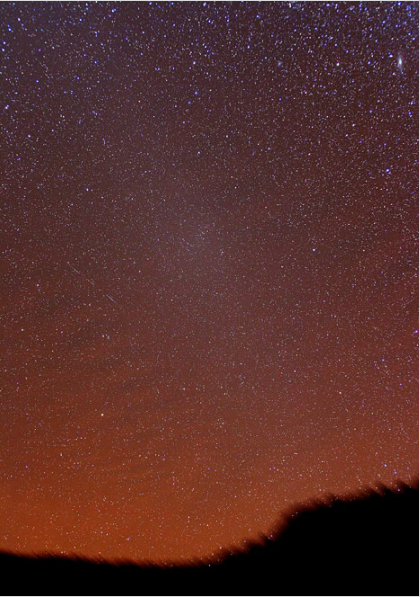Zodiacal Light and Banded Red Airglow
Zodiacal Light and Banded Red Airglow: A Celestial Spectacle
The night sky never fails to mesmerize us with its celestial wonders. Among these captivating phenomena are the Zodiacal Light and Banded Red Airglow. These ethereal displays add a touch of magic to the heavens, enchanting both amateur and professional stargazers alike. Let's delve deeper into these intriguing atmospheric optics phenomena and explore their captivating nature.
The Zodiacal Light: A Cosmic Glow
One of the most enchanting sights in the night sky is the Zodiacal Light. This ethereal glow appears as a faint, triangular-shaped band of light that extends upwards from the horizon after sunset or before sunrise. The Zodiacal Light is caused by sunlight reflecting off tiny dust particles scattered throughout the inner solar system, primarily in the plane of the ecliptic.
The source of these dust particles is still a subject of debate among scientists. Some believe they originate from comets or asteroids, while others suggest they may be remnants of the formation of our solar system. Regardless of their origin, these microscopic particles create a luminous pathway that follows the same path as the zodiacal constellations, hence its name.
Banded Red Airglow: A Celestial Ribbon
Accompanying the Zodiacal Light, we find another celestial spectacle known as Banded Red Airglow. This phenomenon manifests as distinct bands of red or orange light that stretch across the night sky. Unlike the Zodiacal Light, which is caused by scattered sunlight, Banded Red Airglow arises from chemical reactions in Earth's upper atmosphere.
The main culprit behind this stunning display is hydroxyl radicals located approximately 85 kilometers above the Earth's surface. These radicals emit red light when they react with other molecules present in the upper atmosphere. The resulting bands of red airglow create a mesmerizing tapestry that adds an extra layer of beauty to the night sky.
The Gegenschein: A Faint Counterpart
While exploring the night sky, keen observers may also encounter a celestial phenomenon known as the Gegenschein. This faint glow appears opposite the Sun in the night sky and is often mistaken for a distant planet or faint galaxy. The Gegenschein is a reflection of sunlight off interplanetary dust particles located in the plane of the ecliptic.
Similar to the Zodiacal Light, the Gegenschein is believed to originate from dust particles that have been gravitationally captured by Earth. These particles scatter sunlight in a way that creates a diffuse glow visible to those with a keen eye and a dark, unpolluted sky. Witnessing the Gegenschein adds an extra layer of intrigue to the celestial tapestry above.
Capturing the Beauty
Astrophotographers, like Doug Zubenel, have the unique ability to capture the ephemeral beauty of these atmospheric optics phenomena. With their specialized equipment and keen eye for detail, they freeze these celestial moments in time, allowing us to marvel at their splendor long after they have faded from view.
Doug Zubenel's photograph of the Gegenschein and Banded Red Airglow, taken during the Okie-Tex Star Party, showcases the celestial ballet occurring above our heads. The banded red airglow, generated by hydroxyl radicals, adds a touch of vibrant color to the night sky, while the Gegenschein stands as a faint but captivating counterpart to the Sun.
The Magic of the Night Sky
The Zodiacal Light, Banded Red Airglow, and Gegenschein are just a few examples of the captivating celestial phenomena that grace our night sky. These ethereal displays remind us of the vastness and beauty of our universe, igniting a sense of wonder within us. As we gaze upwards, we are reminded of the intricate dance between light, particles, and molecules that creates these mesmerizing spectacles.
Whether you are an amateur stargazer or a seasoned astronomer, take the time to explore the celestial wonders above. Venture to a dark, unpolluted location, and let the night sky envelop you in its magic. Witness the Zodiacal Light as it paints a celestial pathway, marvel at the Banded Red Airglow as it weaves its vibrant tapestry, and catch a glimpse of the elusive Gegenschein. Let the night sky captivate your senses and transport you to realms beyond our earthly existence.

Gegenschein and Airglow
Doug Zubenel captured this gegenschein in a sky ribbed by banded red airglow generated by hydroxyl radicals ~85 km high. The trails are geosynchronous satellites. The satellites show as trails because the camera was guided on the stars for the exposure.
Imaged at the 24th annual Okie-Tex Star Party located in Cimarron County, Oklahoma on the morning of October 10, '07. Canon Digital Rebel XTi (Hutech modified for astrophotography) with a Nikkor fisheye.
Image ©Doug Zubenel, shown with permission.
Note: this article has been automatically converted from the old site and may not appear as intended. You can find the original article here.
Reference Atmospheric Optics
If you use any of the definitions, information, or data presented on Atmospheric Optics, please copy the link or reference below to properly credit us as the reference source. Thank you!
-
<a href="https://atoptics.co.uk/blog/zodiacal-light-and-banded-red-airglow/">Zodiacal Light and Banded Red Airglow</a>
-
"Zodiacal Light and Banded Red Airglow". Atmospheric Optics. Accessed on November 26, 2024. https://atoptics.co.uk/blog/zodiacal-light-and-banded-red-airglow/.
-
"Zodiacal Light and Banded Red Airglow". Atmospheric Optics, https://atoptics.co.uk/blog/zodiacal-light-and-banded-red-airglow/. Accessed 26 November, 2024
-
Zodiacal Light and Banded Red Airglow. Atmospheric Optics. Retrieved from https://atoptics.co.uk/blog/zodiacal-light-and-banded-red-airglow/.